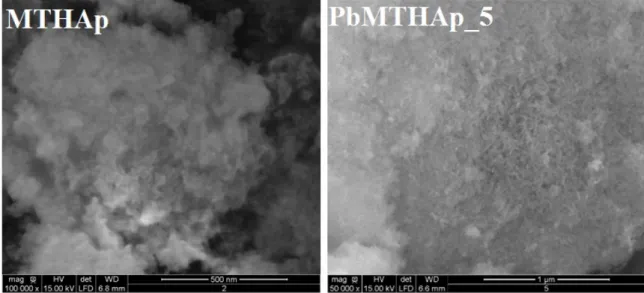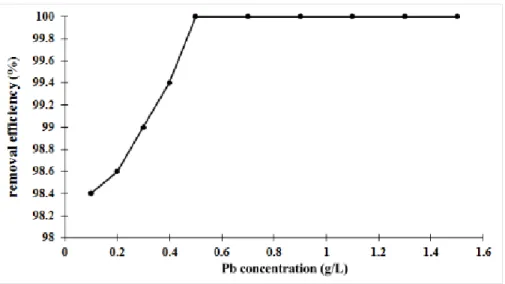HAL Id: insu-01286599
https://hal-insu.archives-ouvertes.fr/insu-01286599
Submitted on 11 Mar 2016HAL is a multi-disciplinary open access archive for the deposit and dissemination of sci-entific research documents, whether they are pub-lished or not. The documents may come from teaching and research institutions in France or
L’archive ouverte pluridisciplinaire HAL, est destinée au dépôt et à la diffusion de documents scientifiques de niveau recherche, publiés ou non, émanant des établissements d’enseignement et de recherche français ou étrangers, des laboratoires
Hydroxyapatite With Environmental Applications
C.L. Popa, C.S Ciobanu, C.C. Petre, Mikael Motelica-Heino, Simona Liliana
Iconaru, G Jiga, D Predoi
To cite this version:
C.L. Popa, C.S Ciobanu, C.C. Petre, Mikael Motelica-Heino, Simona Liliana Iconaru, et al.. Hy-droxyapatite With Environmental Applications. Times of Polymers (TOP) and Composites 2014 7th International Conference, Jun 2014, Ischia, Italy. pp.318-321, �10.1063/1.4876842�. �insu-01286599�
Hydroxyapatite with environmental applications
C. L. Popa, C. S. Ciobanu, C. C. Petre, M. Motelica-Heino, S. L. Iconaru, G. Jiga, and D. Predoi
Citation: AIP Conference Proceedings 1599, 318 (2014); doi: 10.1063/1.4876842
View online: http://dx.doi.org/10.1063/1.4876842
View Table of Contents: http://scitation.aip.org/content/aip/proceeding/aipcp/1599?ver=pdfcov
Published by the AIP Publishing
Articles you may be interested in
Synthesis and photoluminescence study of flower-like hydroxyapatite nanostructure for bioprobe applications
AIP Conf. Proc. 1512, 250 (2013); 10.1063/1.4791005
Calcium Deficient Hydroxyapatite for Medical Application Prepared by Hydrothermal Method
AIP Conf. Proc. 1251, 304 (2010); 10.1063/1.3529307
Gelatine‐Hydroxyapatite Nano‐composites for Orthopaedic Applications
AIP Conf. Proc. 1045, 81 (2008); 10.1063/1.2991353
Thermoluminescence in hydroxyapatite
Med. Phys. 6, 494 (1979); 10.1118/1.594611
Physical science with environmental and other practical applications
Hydroxyapatite With Environmental Applications
C.L. Popa
a,b, C.S. Ciobanu
a, C.C. Petre
c, M. Motelica-Heino
d, S.L. Iconaru
a,b,d, G. Jiga
c,
D. Predoi
a*aNational Institute of Materials Physics , P.O. Box MG 07, Bucharest, Magurele, Romania
*dpredoi@gmail.com
bFaculty of Physics, University of Bucharest, 405 Atomistilor, CP MG-1, 077125 Magurele, Romania cUniversity Politehnica of Bucharest, Faculty of Engineering and Management of Technological Systems,
Department of Strength of Materials,060032, Bucharest, Romania
dISTO, UMR 7327 CNRS-Université d’Orléans, 1A rue de la Férollerie 45071 Orléans Cedex 2, France
Abstract. The aim of this study was to synthetize new nanoparticles based on methyltrimethoxysilane coated
hydroxyapatite (MTHAp) for lead removal in aqueous solutions. The morphological and compositional analysis of MTHAp was investigated by scanning electron microscopy (SEM) equipped with an energy dispersive X-ray spectrometer (EDS). Removal experiments of Pb2+ ions were carried out in aqueous solutions with controlled
concentration of Pb2+ and at fixed pH of 5. After the removal experiment of Pb2+ ions from solutions, porous
hydroxyapatite nanoparticles were transformed into PbMTHAp_5 via the adsorption of Pb2+ ions followed by a cation
exchange reaction. Our results demonstrate that the porous hydroxyapatite nanoparticles can be used as an adsorbent for removing Pb2+ ions from aqueous solution.
Keywords: methyltrimethoxysilane, hydroxyapatite, lead removal
INTRODUCTION
One of the major environmental problems is represented by the global contamination with potentially toxic trace elements (PTTE). Lead has been widely used in the industrial field, for lead-based batteries, ammunition, paints and building materials [1-4]. Due to their non-biodegradable behaviour and their incapacity of metabolization and decomposition, PTTE like Pb, Cu, Cd, Zn and Hg are the main contaminants of soils and ground or surface waters. Their progressive accumulation in the human body can cause significant health problems, inducing chronic illness which untreated, can lead to a painful death.
Among a large variety of PTTE, one of the most dangerous is lead. Recently, the International Agency for Research on Cancer (IARC) has included lead in the list of possible human carcinogens (IARC, 1987) together with its inorganic compounds (IACR 2006) [5]. Therefore, researchers world-wide have focused on developing new and improved methods for removing PTTE from the different environmental compartments such as soils and waters.
In the last decades, a major attention has been given to a special material, hydroxyapatite (HAp) [Ca10(PO4)6(OH)2] due to its remarkable properties. On the other hand, hydroxyapatite (HAp) has a high sorption
capacity for actinides and divalent metals [6-7]. Furthermore, previous studies have revealed a high capacity for removing divalent ions from aqueous solutions [8-16] and contaminated soils [6-17]. For the removal of PTTE from polluted media by synthetic HAp different mechanisms have been reported, like ion exchange [18-21] and substitution of Ca ions in HAp by metals ions [6, 18, 22]. In order to improve the capacity of adsorption, it was shown that there are several factors that must be take into account, among them the type of divalent metal, the physico-chemical properties of HAp, the metal concentration, the solution pH, etc. [23-25].
The aim of this study was thus to prepare methyltrimethoxysilane coated hydroxyapatite (MTHAp) composite powders at nanoscale and to investigate Pb2+ ions removal from aqueous solutions using MTHAp
samples. The morphological and compositional analysis of MTHAp was investigated by scanning electron microscopy (SEM) equipped with an energy dispersive X-ray spectrometer (EDS). Batch experiments at a fixed pH of 5 were conducted with the powders and solutions of lead.
Results and Discussions
Methyltrimethoxysilane coated hydroxyapatite (MTHAp) was prepared using methyltrimethoxysilane and hydroxyapatite. The hydroxyapatite (Ca10(PO4)6(OH)2) nanoparticles were prepared by setting the atomic ratio of
Ca/P at 1.67 in accord with [26]. The hydroxyapatite (HAp) was immobilized into a methyltrimethoxysilane foam using the technique reported in the literature [27]. MTHAp was obtained when methyltrimethoxysilane solution (1 g HAp/10 ml) was dropped on the HAp powder. The mixtures were then stirred vigorously for 30 min until homogeneity was achieved. After forming stable structures, MTHAp composites were allowed to dry in a vacuum oven at 80°C for 24 h for the the excess solvent to evaporate. Finally, MTHAp composite samples were then ground to obtain powders.
Removal performance of Pb2+ ions by the MTHAp composite powders was investigated by batch
experiments and monitoring the change of Pb2+ ion concentration in the aqueous solution. For these experiments, 5 g
of MTHAp composite sample was put into 500 ml aqueous solution with various initial Pb2+ ion concentrations and
pH values in accord with Suk Hyun Jang et al. [8]. The initial Pb2+ ion concentrations of the aqueous solutions were
controlled and the values were set in the range 0.1-0.9 g·L-1 by dissolving lead nitrate [Pb(NO
3)2] in deionized water.
The pH value of aqueous solutions with a controlled initial Pb2+ ion concentration was adjusted to 5 by adding small
amounts of 0.1M HCl standard solution. For all experiments the solution was stirred constantly for 24 h by a mechanical stirrer at room temperature.
Scanning electron microscopy (SEM) study was performed on a HITACHI S2600N-type microscope equipped with an energy dispersive X-ray attachment (EDAX/2001 device).
The hydroxyapatite coated with methyltrimethoxysilane before and after the reaction with the Pb2+
ion-containing solution with pH 5 for 24 h were investigated by SEM and results are presented in Figure 1. Distinct morphologies were observed in the SEM micrographs. The presence of Pb10(PO4)6(OH)2 crystals were identified by
crystal clusters with needle or rod-like shapes. These results are in good agreement with preliminary studies performed by Cheol Y. Kim et al. [28].
Figure 1: SEM micrographs of hydroxyapatite coated with methyltrimethoxysilane (MTHAp) before and after the reaction with a
solution containing 950 mg of Pb/L at pH 5 (PbMTHAp_5).
The concentration of Pb2+ ions remaining in the solution after the MTHAp reacted with the Pb2+
ion-containing solution was determined by flame atomic absorption spectroscopy (Hitachi Z-8100 spectrophotometer). The impact of the concentration of lead in the aqueous solution was studied by absorption experiments realized at 25°C within MTHAp and with a concentration range of 0.1– 0.9 g·L-1 at pH 5. Measurements were
performed on 500 mL solution (pH 5) with an initial Pb2+ ion concentration of 63 mg·L-1. Figure 2 presents the
adsorption efficiency of Pb2+ ions as a function of the Pb concentration in solution. It was noticed that the removal
removal efficiency reached 98.4%, showing that the adsorbent composite, MTHAp, had a strong affinity to the Pb2+
ions. At Pb concentration from 0.5 g·L-1 to 1.5 g·L-1, the removal efficiency was nearly 100%. In this case, the Pb2+
ions in the solution were completely removed. For the studies on the effect of the solution pH, the lead concentration dosage of 0.9 g·L-1 was selected.
Figure 2: Effect of the Pb concentration on the removal of the Pb2+ ions by MTHAp.
Following these results, it can be emphasized that MTHAp can effectively remove Pb2+ ions from the
aqueous solution. In agreement with previous studies [3], the formation of the new crystals was identified. Distinct morphologies were observed in the SEM micrographs. Scattered needle- or rod-shaped crystals were observed in the sample obtained from the reaction performed at pH 5. Q. Y. Ma et al. [29] reported similar crystals in previous studies. This research showed that the MTHAp nano-composite material is a promising adsorbent for Pb2+ ions from
aqueous solution at various pH values and could be used as a wastewaters purifier.
ACKNOWLEDGMENTS
The financial and encouragement support provided by the Ministery of Educations of Romania under the project IFA-CEA C2-06.
REFERENCES
1. W. Liang, L. Zhan, L. Piao and C. Russel, Mat. Sci. Eng. B 176, 1010-1014 (2011). 2. L. Dong, Z. Zhu, Y. Qiu and J. Zhao, Chem. Eng. J. 165, 827–834 (2010).
3. X. Chen, J.V. Wright, J.L. Conca and L.M. Peurrung, Environ. Sci. Technol. 31, 624–631(1997). 4. M. Miyake, K. Ishigaki and T. Suzuki, J. Solid State Chem. 61, 230–235 (1986).
5. J. Garcia-Leston, J. Mendez, E. Pasaro and B.Laffon, Environ. Int. 36, 623-636 (2010). 6. R.R. Sheba, J. Colloid. Interf. Sci. 310, 18-26 (2007).
7. A. Krestou, A. Xenidis and D. Panias, Miner. Eng.17, 373 (2004).
8. S.H. Jang, Y.G. Jeong, B.G. Min, W.S. Lyoo and S.C. Lee, J. Hazard. Mat. 159, 294-299 (2008). 9. T. Suzuki, K. Ishigaki and M. Miyake, J. Chem. Soc. Faraday Trans.80, 3157–3165 (1984). 10. Q.Y. Ma, S.J. Traina, T.J. Logan and J.A. Ryan, Environ. Sci. Technol. 27, 1803–1810 (1993). 11. Y.P. Xu and F.W.Schwartz, J. Contam. Hydrol.15, 187–206(1993).
12. S.K. Lower, P.A. Maurice, S.J. Traina, Geochim. Cosmochim. Ac. 62, 1773–1780 (1998).
13. E. Mavropoulos, A.M. Rossi, A.M. Costa, C.A.C. Perez, J.C. Moreira and M. Saldanha, Environ. Sci. Technol. 36, 1625– 1629 (2002).
14. G. Lusvardi, G. Malavasi, L. Menabue and M. Saladini, Waste Manage. 22, 853–857(2002). 15. E. Deydier, R. Guilet and P. Sharrock, J. Hazard. Mater.101, 55–64 (2003).
16. N. Arnich, M.C. Lanhers, F. Laurensot, R. Podor, A. Montiel and D. Burnel, Environ. Pollut.124, 139–149 (2003). 17. P.K. Chaturvedi, C.S. Seth and V. Misra, Chemosphere 64, 1109-1114 (2006).
18. A. Corami, S. Mignardi and V. Ferrini, J. Colloid. Interf. Sci. 317, 402-408 (2008). 19. Y. Xu, F.W. Schwartz and S.J. Traina, Environ. Sci. Technol. 28, 1472-1480 (1994).
20. A.G. Leyva, J. Marrero, P. Smichowski and D. Cicerone, Eviron. Sci. Technol.35, 3669-3675 (2001). 21. J.A. Gómez del Río, P.J. Morando and D.S. Cicerone, J. Environ. Manage.71, 169-177 (2004). 22. J. Jeanjean, U. Vincent, M. Fedoroff, J. Solid State Chem.108, 68-72 (1994).
23. I. Smiciklas, A. Onjia, S. Raicevic, D. Janackovic and M. Mitric, J. Hazard. Mater.152, 876-884 (2008).
24. F. Monteil-Rivera and M. Fedoroff, Encyclopedia of Surface and Colloid Science. Marcel Dekker Inc. NY, USA, 2002; pp. 1–26.
25. L.Q. Ma, J. Environ. Qual.25, 1420–1429 (1996).
26. A. Costescu, I. Pasuk, F. Ungureanu, A. Dinischiotu, M. Costache, F. Huneau, S. Galaup, P. Le Coustumer and D. Predoi, Dig. J. Nanomater. Bios.5,989-1000 (2010).
27. D. Dieterich, E. Grigat, W. Hahn, H. Hespe and H.G.Schmelzer, Principles of polyurethane chemistry and special
applications, in: G. Oertel (Ed.), Polyurethane Handbook: Chemistry, Raw Materials, Processing, Application, Properties; Second ed., Hanser, Munich, 1994; pp 11-31.
28. C.Y. Kim, H.J. Kim and J.S.Nam, J. Hazard. Mater.153, 173–178 (2008). 29. Q. Y. Ma, T. J. Logan, S. J. Traina, Environ. Sci. Technol.29, 1118-1126 (1995).

